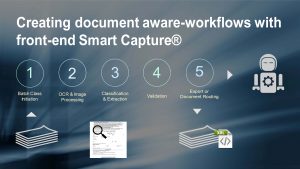Ephesoft Smart Capture® can positively impact claim processing for the insurance industry, particularly in conjunction with an automation platform like an RPA system. According to the National Association for Insurance Commissioners, last year written insurance premiums in the US came to $1.15 trillion dollars. With nearly every person in America purchasing at least one insurance policy, competition for business is incredibly intense.
The following extract is from our Smart capture solutions demonstration in the US market for an insurance claim use case.
There are approximately 6,000 domestic insurance companies in the US that employ 2.6 million people. This means that now more than ever, it’s crucial for insurers to maintain high levels of customer satisfaction to sustain recurring business as well as attract new policyholders. Unfortunately for these company stakeholders, profit margins on policies are razor thin. As such, it’s natural for business owners to look for areas of the operation where costs may be saved without sacrificing the quality of the customer’s experience. The actual paper-based process of the insurance claim workflow is an ideal candidate for efficiency gains and cost savings.
For example, let’s consider home or renters insurance. Making a claim against a homeowners’ insurance policy typically occurs at a time of great stress for the policyholder. Damage to your residence causes at the very least inconvenience and at worst temporary relocation while home repairs are made. It follows that the more quickly a claim is processed – decisions finalized, payments made, funds transferred – the better for the homeowner and insurance customer. All of this translates to higher customer satisfaction ratings.
Automating Workflow with AI-based Tools Drives Customer Satisfaction
With Ephesoft Transact, our Smart Capture platform, insurance companies can automate the document workflow of claim ingestion and review by providing more immediate access to claim-related documents and customer correspondence. Through a combination of supervised machine learning and rules-based logic, Ephesoft Transact automatically categorizes, separates and extracts data from insurance documents however they’re sent to the agency’s intake site. No need for barcode application, document preparation or manual data entry. And we’ve found that implementing intelligent capture software improves processing performance specifically in the insurance industry by about 80%.
We know that a major part of the business of insurance revolves around document processes and the data that lies within those documents, all of which is highly repeatable and therefore has a huge potential for automation. Working seamlessly with RPA systems, Ephesoft Transact aims to reduce processing time, increase efficiency and eliminate errors in this document-centric industry. Therefore, digging into the actual technology behind Ephesoft Transact, let’s understand the method of how the application handles unstructured documents in this type of workflow.
Step-by-Step Claim Processing

The first step in a claim processing workflow is kicking off a Batch process in Ephesoft Transact, which is how Ephesoft refers to electronic documents working their way through classification and extraction projects. This can be represented by a few different actions. For one, Ephesoft Transact can act as the point of document on-ramping for downstream workflows. Maybe we’re monitoring a hot folder where digital claim forms are routed after being scanned in bulk at the mailroom. Or, we could be monitoring an email inbox or a fax server folder for new and incoming claims. Ephesoft Transact can also operate as an activity within a robotic process. The first step of this document processing workflow could be an API call to a Transact server from an RPA system like UiPath or Blue Prism. This Web Services call could send documents used in that workflow from the RPA server to the Transact server to run through the pre-configured project.
Next, we move on to image processing where basic image enhancements are applied to the claim file pages and the document is rendered fully text searchable through an embedded OCR engine.
After that, the Ephesoft Smart Capture platform assembles the pages into single documents and categorizes the documents according to full content analysis. We use unique classification algorithms that don’t require the creation of rigid document templates for highly accurate categorization.
When the claim documents are sorted, Ephesoft Transact utilizes a combination of preconfigured rules-based logic and supervised machine learning to identify and extract key pieces of metadata. These pre-defined extraction methods include capture mechanisms, such as key value pair extraction where the application searches for anchor values near a desired field, pattern matching utilizing regular expressions, fuzzy database lookups and tabular extraction.
Once Ephesoft Transact has analyzed the content and completed the data extraction step, the documents may be routed to a validation queue for verification or remediation of machine extracted index fields. Fields may be highlighted in a validation User Interface based on the confidence score (or certainty of correct information) determined by the application. For example, if after this text analysis, Ephesoft Transact’s output for the field policy number or claim number falls below the designated confidence value, Ephesoft Transact’s built-in document processing workflow will trigger that document (and that specific field) to be flagged for review by an end-user. And unless validation is required, an end user of an assisted or monitored robot may never even interact with the Transact server that’s processing the documents.
The final step in the claims document processing workflow will depend on how this project has been configured. In a stand-alone capacity, Ephesoft Transact may simply export the content – represented by the sorted documents and their associated data files – to their final location. This can be a records management system, content repository like Box, or it can simply mean sending the document to a hot folder for a down-stream system to pick up and use. When used in conjunction with an RPA system, however, this export routing step is replaced by the API call to a Transact server to have a batch of documents processed. In this case, the metadata and/or documents are automatically available for the robotic process as soon as the batch is complete.
Request a Demo
Learn more about the Ephesoft transact application.
Please get in touch and start your journey in digital transformation.



